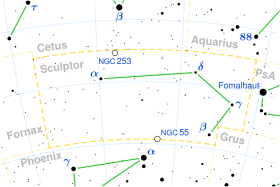Eta Sculptoris
| Observation data Epoch J2000 Equinox J2000 | |
|---|---|
| Constellation | Sculptor |
| Right ascension | 00h 27m 55.69870s[1] |
| Declination | −33° 00′ 25.7977″[1] |
| Apparent magnitude (V) | 4.81[2] |
| Characteristics | |
| Spectral type | M4III[3] |
| U−B color index | +1.81[2] |
| B−V color index | +1.64[2] |
| Variable type | semiregular variable[4] |
| Astrometry | |
| Radial velocity (Rv) | +12.10[5] km/s |
| Proper motion (μ) | RA: −20.10[1] mas/yr Dec.: −49.94[1] mas/yr |
| Parallax (π) | 7.22 ± 0.51[1] mas |
| Distance | 450 ± 30 ly (139 ± 10 pc) |
| Absolute magnitude (MV) | −0.83[6] |
| Details | |
| Luminosity | 1,082[7] L☉ |
| Temperature | 3,621[7] K |
| Other designations | |
| Database references | |
| SIMBAD | data |
Eta Sculptoris, Latinized from η Sculptoris, is a single,[8] red-hued star in the southern constellation of Sculptor. It is a M-type red giant[3] approximately 450 light years from Earth.[1] Eta Sculptoris is classified as a semiregular variable and its apparent magnitude fluctuates between +4.80 and +4.90,[4] It pulsates with multiple periods of 22.7, 23.5, 24.6, 47.3, 128.7 and 158.7 days.[9]
References
- 1 2 3 4 5 6 Van Leeuwen, F. (2007). "Validation of the new Hipparcos reduction". Astronomy and Astrophysics. 474 (2): 653. arXiv:0708.1752. Bibcode:2007A&A...474..653V. doi:10.1051/0004-6361:20078357. Vizier catalog entry
- 1 2 3 Ducati, J. R. (2002). "VizieR Online Data Catalog: Catalogue of Stellar Photometry in Johnson's 11-color system". CDS/ADC Collection of Electronic Catalogues. 2237. Bibcode:2002yCat.2237....0D.
- 1 2 Hoffleit, D.; Warren, W. H. (1995). "VizieR Online Data Catalog: Bright Star Catalogue, 5th Revised Ed. (Hoffleit+, 1991)". VizieR On-line Data Catalog: V/50. Originally published in: 1964BS....C......0H. 5050. Bibcode:1995yCat.5050....0H.
- 1 2 Watson, Christopher (25 August 2009). "Eta Sculptoris". AAVSO Website. American Association of Variable Star Observers. Retrieved 20 July 2014.
- ↑ Gontcharov, G. A. (2006). "Pulkovo Compilation of Radial Velocities for 35 495 Hipparcos stars in a common system". Astronomy Letters. 32 (11): 759. arXiv:1606.08053. Bibcode:2006AstL...32..759G. doi:10.1134/S1063773706110065.
- ↑ Anderson, E.; Francis, Ch. (2012). "XHIP: An extended hipparcos compilation". Astronomy Letters. 38 (5): 331. arXiv:1108.4971. Bibcode:2012AstL...38..331A. doi:10.1134/S1063773712050015. Vizier catalog entry
- 1 2 McDonald, I.; Zijlstra, A. A.; Boyer, M. L. (2012). "Fundamental parameters and infrared excesses of Hipparcos stars". Monthly Notices of the Royal Astronomical Society. 427: 343. arXiv:1208.2037. Bibcode:2012MNRAS.427..343M. doi:10.1111/j.1365-2966.2012.21873.x. Vizier catalog entry
- ↑ Eggleton, P. P.; Tokovinin, A. A. (September 2008). "A catalogue of multiplicity among bright stellar systems". Monthly Notices of the Royal Astronomical Society. 389 (2): 869–879. arXiv:0806.2878. Bibcode:2008MNRAS.389..869E. doi:10.1111/j.1365-2966.2008.13596.x.
- ↑ Tabur, V.; Bedding, T. R. (2009). "Long-term photometry and periods for 261 nearby pulsating M giants". Monthly Notices of the Royal Astronomical Society. 400 (4): 1945–61. arXiv:0908.3228. Bibcode:2009MNRAS.400.1945T. doi:10.1111/j.1365-2966.2009.15588.x.
This article is issued from
Wikipedia.
The text is licensed under Creative Commons - Attribution - Sharealike.
Additional terms may apply for the media files.
